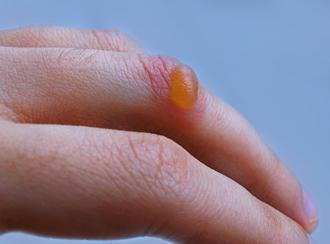
Most people experience blisters on their feet, often due to friction or pressure from tight or poorly fitted shoes; however, blisters can develop just about anywhere on the body. If clothes are too tight or you are running you may find a blister on other parts of the body, as well. Whether your blisters are due to physical activity or you think they might be caused by an underlying skin problem, a dermatologist is going to be the best medical professional to turn to for answers and care.
Treating Blisters
If you are a healthy individual then you can easily treat blisters with simple first aid and home care; however, those with diabetes or weakened immune systems should call their dermatologist for treatment. Even minor skin injuries such as blisters can lead to an infection if you have certain preexisting conditions.
To treat a blister at home here are some helpful tips:
Cover the area: Just as you would place protective padding over a bunion or a callus, you should do the same for a blister. This will provide an additional layer of protection to prevent shoes or clothes from rubbing against the blister to make it worse.
Don’t pop the blister: We know that it might be tempting to pop the blister but it’s best just to leave it alone and to let your body heal it naturally; however, we also understand that the blister may be large, painful, or in an awkward place and you may need to drain it. In this case, make sure to thoroughly sterilize a needle with alcohol before gently piercing the blister so that it can drain.
Clean the area: If you do decide to drain the blister yourself, it’s important that you keep the area as clean as possible afterward to prevent infection. This means cleaning the area with soap and water after draining it.
When to See a Doctor
In some cases, a blister may need to be treated by a medical professional; more specifically, a dermatologist. If the blister doesn’t get better in a few days or shows signs of infection, you need to see a doctor as soon as possible. If you develop clusters or several blisters on your body, along with other symptoms such as fever and pain, these could be signs of a viral infection, skin disease, or autoimmune disorder. Conditions such as impetigo, herpes zoster, and dermatitis herpetiformis can also cause blisters.
If you are dealing with a painful or infected blister, or if you have diabetes, it’s important that you turn to a dermatologist right away for treatment to prevent complications.
